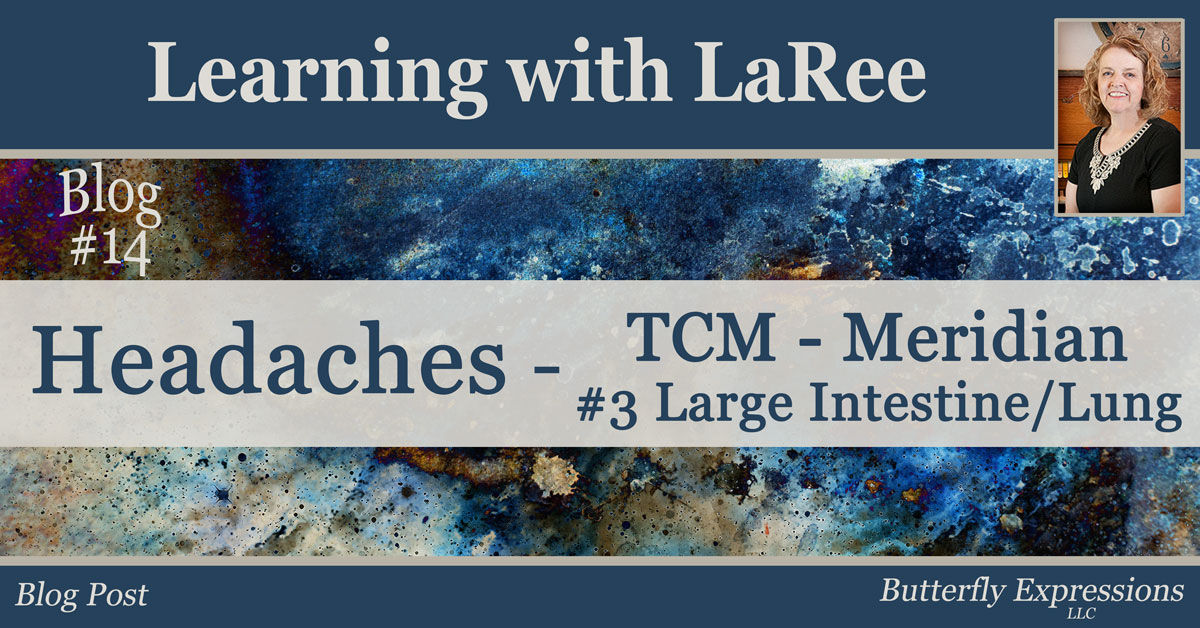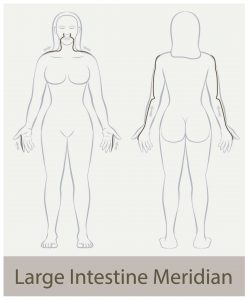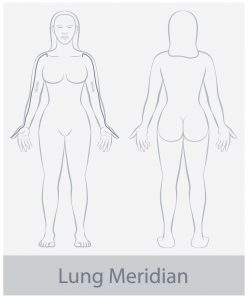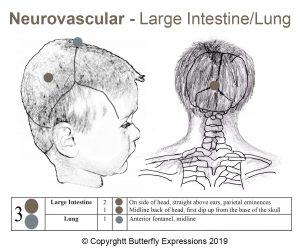#14 TCM Headaches – 3 Large Intestine/Lung

#14 -TCM Headaches – 3 Large Intestine/Lung
Below is a brief explanation of two ways in which headaches and migraines may be connected to the large intestine/lung meridian pair. A more complete explanation, as well as discussion of a couple of interesting neurotransmitters created in the gut but affecting the head, will take place in the blood sugar/digestive segment of this series of articles on headache and migraines.
Metal is the earthly element associated with this meridian. The season is late fall. Harvest is over. The earth prepares for winter. The life energy of plants and even animals, each in their own way, withdraws into themselves in preparation for the winter season.
This meridian pair is labeled “The Alchemist.” People strong in this meridian’s energy have the ability when in balance, to distill truth from life’s experiences and to bring order from chaos. (Alchemy was the term used in the far distant past for attempts to make gold from lesser elements.)
The Large Intestine/Lung part of the meridian cycle of life is about the coming of death. This refers to the final death as well as the little “deaths” that change and moving on in life brings to each of us. Therefore, this is a season of learning to cope with grief. Grief should not be about regret. Rather, it should be about remembering and letting go. Wisdom and peace can be the gifts of this season.
Large Intestine and Lung, organs and meridians – in balance
- First, they are high achievers.
- They maintain their own standards of excellence and purity while being sympathetic to the struggles of others.
- They express ideas clearly and very articulately when calm and in balance.
- Neat, orderly and meticulous.
- Logical, analytical, and reflective. Work systematically.
- Accepts authority – but only if the person actually knows more than they do!
- Temperate and moderate. Persistent, however.
- Make excellent leaders when placed by others in those positions. Rarely puts themselves forward for a position of authority.
- Often exhibit great depths of kindness, honesty, and integrity.
Large Intestine and Lung, organs and meridians – out-of-balance
- Vulnerable to becoming overly serious.
- Consequently, they are usually restrained in their relationships.
- Tries to cram more into each day than can possibly be accomplished.
- They often sink into depression from self-inflicted pressure to reach perfection.
- The person displays either low self-esteem or self-righteousness. (Interesting double-sided attributes here.)
- Find it difficult to forgive self and others.
- Expresses impatience when others fail to live by the rules.
- Inability to adapt to changes or make changes when they are required.
Physical Complaints
All physical issues reflect the dryness that plagues the out-of-balance aspects of this meridian.
- Stiff joints and muscles.
- Dry hair and skin.
- Sensitivity to climate, climate changes, and weather patterns.
- Poor circulation.
- Acne.
- Respiratory problems especially coughs.
Balance Restored By
- Since metal is associated with dryness, water is the key to restoring balance.
- Going for a swim.
- Drinking plenty of water.
The Large Intestine The “Brain of the Gut”
Based on current research, the digestive system, often called “the gut,” actually has a brain-like nervous system of its own. This “brain of the gut” has been named the Enteric Nervous System. Research clearly shows that this brain functions quite well on its own, quite independent, in some ways, from the brain in the head. It requires little or no input from the brain in the head in order to carry out many of its most important functions. On the other hand, we know that the brain and the gut often communicate with each other.
Stress and strong emotions are often felt first in the gut as nausea or “butterflies.” I am sure you have experienced a “gut-feeling” or two, yourself. These feelings, both physical and emotional, often occur long before our brain – the one in our head – has sorted things out.
Interestingly, as far as headaches and the digestive tract are concerned, some people report that removing their gallbladder actually improved, or ended completely their migraine headaches. It stands to reason, then, that if we strengthen the entire digestive tract, including the gallbladder, we would make a difference in those headaches where neurological communication between the gut and the head is creating the headache.
The Vagus Nerve
The vagus nerve connects the enteric nervous system – the brain in the gut – to the brain in the head. The vagus nerve is a major part of the nervous system that is affected during a migraine attack. Thus we have a very definite physiological connection between headaches and migraines and the digestive tract, particularly the large intestine.
Neurotransmitters and the Large Intestine
The body requires a great many neurotransmitters in order to perform the multitude of tasks required of it each day. Research in recent years has shown, clearly, that the gut is responsible for the production of more than of few of these neurotransmitters. Let’s talk about just one of them for a moment – serotonin. This chemical nerve transmitter is involved in a great many functions.
Some Functions of Serotonin.
- Prevents depression.
- Stabilizes mood and mood swings.
- Reduces anxiety.
- Physically, serotonin plays several roles in the maintenance of bone health.
- Bone health. Clogged serotonin receptors and destruction mechanisms cause serotonin levels to get too high. Too much serotonin damages bones.
- Improves brain chemistry and function.
- Stimulates areas of the brain responsible for sleep.
- Stimulates nausea so that the body can eliminate toxins and poisons.
- Essential to blood clotting and wound healing.
- Plays a role in libido and sexual function.
- Plays a key role in both the cause and the cure for migraine headaches.
- Above all, serotonin is absolutely essential to communication between nerves.
The intestinal tract produces about 80% of this very important neurotransmitter. In addition, the bowel has at least seven different receptors that respond to serotonin.
Problems in the intestinal tract are linked, statistically and scientifically, to such things as autism, bipolar and borderline personality disorders, depression, and a host of other ailments.
Serotonin is produced in the body from, among other things, the essential amino acid tryptophan. This amino acid is found in foods such as nuts, cheese, and red meat. Triptan (yes, the name is no accident) medications work on serotonin production and receptor sites. Triptan medications are the largest class of FDA approved medications for the relief of migraine headaches. An interesting development in the treatment of IBS (Irritable Bowel Syndrome) is that patients on tryptophan anti-depressant or headache medication obtained relief for their bowel issues.
There is no longer any question that gut health affects both migraine headaches and brain function.
Large Intestine Related Headaches
Since gut health impacts the absorption and utilization of nutrients and the elimination of toxins, headaches of nearly every type and description may be related to gut health. The types of headache pain and the types of migraines associated with the lungs and lack of oxygen are just as varied as those associated with gut health! Nearly every type of headache described in the previous article also applies to both gut-related and lung-related headaches.
The pain of digestive related headaches sometimes alternates between the head and the stomach and bowel area.
- All over the head. The head feels dull and heavy. The pain is mostly across the forehead. The entire digestive tract is, unquestionably, going to be out of balance.
- Localized pain. Stabbing, splitting pain. Pain manifests either along the gallbladder meridian in the head or along the collateral nerves this meridians energy feeds. Localized to a small area. It may be intermittent – coming and going – but the coming and going of the headaches will be continual, perhaps even chronic.
- Occipital headache. Shock-like pains coming from the occiput. Vertigo and flashing lights of an aura-type migraine. Occiput becomes tender to the touch.
- Band around the head. The head feels as if a band, over the eyes and extending all around the head, is becoming increasingly tighter and tighter.
- Behind or above the eyes. Headache pain behind or just above the eyes. Many times, this type of headache as related to the lungs, involves only the left eye. Often related to changes in altitude.
- Top of the head – Vertex. The top of the head is, typically, the location of the majority of the pain. Feels as though a large nail is being driven into the head. May involve asthma, especially in children.
- All over the head. Head feels distending and about to burst, rather than heavy. Irritable and easily angered. Dizziness, blurred vision, and vertigo.
Possible Large Intestine Remedies
Herbal Solutions
The Nervine remedies NV, NS, NT, and NVC are always appropriate for headache pain. The herbal formulas specific to the Large Intestine and the organs connected with it include CD, CAC, LB, PARA. You should also look at the HD remedy. Single herbs include Cape Aloes, Aloe Vera, Catnip, Cat’s Claw, Fennel, Cascara Sagrada, Barberry, Licorice Root, Milk Thistle, Slippery Elm, Cramp Bark, Oregon Grape, Papaya Leaf and Fruit, Peach Leaf, Peppermint, Propolis, Sarsaparilla, Squawvine, and Marshmallow.
Essential Oils
Single oils for the large intestine include Anise, Basil, Cardamom, Coriander, Cypress, Elemi, Fennel, Fenugreek, Hyssop, Marjoram, Mountain Savory, Patchouli, Senna (with reason and common sense), Spikenard, Tarragon, Turmeric, and Yarrow. Butterfly Blends for the digestive system in general and the functions of the large intestine include LeEmerge, LeInsideOut, LeJulia, LeLetting Go, LeRevitalize, and LeSynopsis.
The Large Intestine Meridian responds well to essential oils of Basil, Bergamot, Cedarwood, Clove, Cypress, Elemi, Fennel, Frankincense, Lavender, Myrrh, Sandalwood, Tea Tree, Thyme, and Yarrow. Butterfly blends for this meridian include LeAssurance, LeBelieve, LeCinnamon Bear, LeEternity, LeGrateful Heart, LeLetting Go, LeMillenia, LeSanctuary, LeReconcilliation, LeSafeGuard, LeTrust, LeWarmDown (cramping), and LeWisdom.
(For explanations of some of these oils as they apply to these meridians, please see Butterfly Miracles with Essential Oils, Chapter 12 – Eastern Healing Philosophy, under the information for the #3 meridian pair, Metal/Season of Late Fall.)
Homeopathic Remedies
Homeopathic low potency combinations to consider include Rescue Remedy, ER911, the Large Intestine Meridian Balance remedy, Glandular Support #3, Migraine #1 and Migraine #2, Headaches #1 and #2, Nerve #1 and Nerve #2. Low potency combination remedies are very helpful, especially if you are not really familiar with homeopathic principles. They can bring relief, even instant relief.
Healing at a deeper level usually requires a single remedy in a higher potency. There are pages and pages of suggested remedies in decent homeopathic repertories. The ones listed here also include headaches symptoms. This is by no means a complete list. Ars, Calc, Chel, Cina, Ferr, Ferr-p, Gels, Mag-c, Phyt, Sep, and Verat.
Possible Meridian Points
CV 6 – Sea of Chi. Press gently. Relieves pain in the abdomen and aids in the relief of constipation. Excellent for digestive disorders that include headache and fatigue.
CV 12 – Center of Power. It is best to use this point when the stomach is almost empty. This is an especially powerful point. Stimulate gently and for no more than a minute or two. Excellent point for anything related to digestion and emotional stress.
Liv 4 – This point stands out because it brings relief to many conditions. This point is indicated for digestion issues as well as for conditions related to the head. Liv 4 is absolutely perfect for headaches brought about by digestive issues. It is equally useful for digestive issues brought about by a headache.
LI 11 – A vital trigger point for the colon. Incidentally, this point is also useful in reducing fevers.
An additional point for stress relief
PC 6 – A major stress-relieving point. Keynotes include headache with dizziness and vertigo.
Endpoints
Placing your fingers on the endpoints of a meridian, especially with an appropriate essential oil on your fingertips, strengthens the flow of that meridian. Better yet, is to put the essential oil on your palms and “run” the entire meridian. If the energy of that meridian is very out of balance, it can be useful to run it in the opposite direction of its normal flow – run it backwards once or twice. Then, run it in its normal direction a few times.
Placing essential oils on other Meridian points works very well. The neurovascular points for the Large Intestine meridian, pictured below, would be especially appropriate.
The Lung
The lungs are, also responsible for oxygenating the blood. The blood, then, brings oxygen to every cell, tissue, and organ of the body. Hypoxia is the term applied to blood not having sufficient oxygen to supply the needs of body tissues and organs. When a person reaches a hypoxic state, the brain, naturally, is not receiving sufficient oxygen, either. Hypoxia is a serious condition. Headache, confusion, and difficulty communicating are a big part of this picture. Other symptoms include bluish or cherry red skin, cough, too fast or too slow heart rate, rapid breathing, shortness of breath, sweating, and wheezing. Immediate treatment is absolutely necessary when hypoxia is occurring.
Traditional Chinese
Chinese medicine believes that new ideas and inspiration are brought into the body on the breath. In addition, they believe that old ideas – those that are no longer of use to us – are expelled from the body and the mind on the breath.
Lung Related Headaches
The types of headache pain and the types of migraines associated with the lungs and lack of oxygen are many and varied! Nearly every type of headache described in the Stomach/Spleen blog of this article also applies to both gut-related and lung-related headaches. The headaches described above involve both the lung and the intestinal tract.
Possible Remedies
Herbal Solutions
The Nervine remedies mentioned above, in the Herbal Remedies section on of the Large Intestine discussion, and HD are always appropriate for headache pain. Magnesium and Potassium, as discussed above, would also be helpful. Other herbs to consider are Anise (both lung and digestive), Bay Leaf, Bee Pollen, Cayenne, Chickweed, Coltsfoot, Elderflower, Elecampane, Horehound, Horsetail, Hyssop, Moringa, Spikenard, and Wild Cherry Bark. Butterfly combinations include BRON, LCON, MULC, PL, and WC.
Essential Oils
Single oils for the Lung include Anethi, Eucalyptus, Marjoram, Orange Sweet, Oregano, Peppermint, and Ravensara. Butterfly essential oils blends for the lung include LeAmbition, LeAspire, LeAutumn, LeBountiful, LeBreezey, LeCherish, LeHoliday Spirit, LeHousewarming, LeMariah, LeSanctuary, and LeStefanie,
The Lung Meridian responds well to essential oils of Bergamot, Birch, Cajeput, Cardamom, Clove, Eucalyptus, Fennel, Frankincense, Lavender, Myrrh, Peppermint, Pine, Tea Tree, Thyme, and Yarrow. Butterfly blends to consider for the lungs are LeAspire, LeBelieve, LeBreezey, LeExhale, LeMillenia, LeSanctuary, and LeTrust.
(For explanations of some of these oils as they apply to these meridians, please see Butterfly Miracles with Essential Oils, Chapter 12 – Eastern Healing Philosophy, under the information for the #3 meridian pair, Metal/Season of Late Fall.)
Homeopathic Remedies
Homeopathic/Blessed Water low potency combinations to consider include Rescue Remedy, ER911, the Lung Meridian Balance Remedy, Glandular Support #3, Migraine #1 and Migraine #2, Headaches #1 and #2, Nerve #1 and Nerve #2. Combination remedies specific to Lung issues include Allergies #4, and any of the Respiratory Distress combinations – #1 – #5. Low potency combination remedies are very helpful, especially if you are not really familiar with homeopathic principles and/or are not experienced enough to use higher potency remedies well and safely. They can bring relief, even instant relief.
Deeper level healing requires a single remedy in a higher potency. There are pages and pages of suggested remedies in decent homeopathic repertories. The remedies listed here have symptoms in the lung, the intestinal tract, and the head. Acon, Ant-t, Ars, Ars-i, Calc, Carb-v, Coca, Ip, Kali-bi, Kali-c, Lob, Merc-i-r, Sep, Thuj, and Tub.
Possible Meridian Points
Lu 7 – A point for “breathing in life to the fullest extent.” This point balances anything respiratory tract related. Also for the lung meridian emotions of grief and sadness.
Lu 9 – Considered the “source point” for the lung meridian. Relaxes the lungs and balances the meridian. Reaches deep into the psyche and spiritual levels.
K 27 – A very well-known and basic point. Works with the lungs and with such lung emotions as depression and anxiety.
LI 20 – Located at the edges of the nostrils. Treats respiratory issues and sinusitis. Reduces facial swelling, facial paralysis, and headaches due to respiratory or sinus problems.
Endpoints
Placing your fingers on the endpoints of a meridian, especially with an appropriate essential oil on your fingertips, strengthen the flow of that meridian. Better yet, is to put the essential oil on your palms and “run” the entire meridian. If the energy of that meridian is very out of balance, it can be useful to run it in the opposite direction of its normal flow – run it backwards once or twice. Then, run it in its normal direction a few times.
Placing essential oils on Meridian points works very well. The neurovascular points for the Lung meridian, pictured below, would be especially appropriate. Using an essential oil on your fingertips when holding any of the points below makes point holding even more effective.

























live longer | 5th Aug 19
Your way of describing the whole thing in this post is genuinely fastidious, all can easily understand it, Thanks a lot.